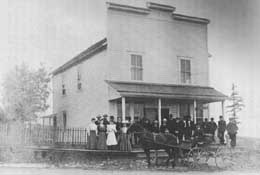On August 31, 1995, Shoreline officially incorporates as a city. Residents of unincorporated King County between Seattle and Snohomish County and between Puget Sound and Lake Washington had voted to incorporate as a city on September 20, 1994. Although Shoreline does not have a discrete business district as do communities such as Woodinville and Burien, it has a school district which generally defines the boundaries. With a population of 50,352, Shoreline is the 10th largest city in the state, just smaller than Vancouver.
Since Seattle pushed its boundary to N 145th Street in 1954, the unincorporated part of King County was developed in a casual manner. Interstate 5 opened in 1966 and the area saw increased growth, but without a central business district and with only a limited voice in county government. The relatively affluent residents did establish a good-quality school district.
In 1987, the Shoreline Incorporation Study Committee began seriously investigating becoming a city as a way to keep more tax monies in the area while retaining the existing sewer and fire districts. But residents failed to express enthusiasm for becoming a city and the group dissolved after a year later.
In 1991, interest in becoming a city increased after King County started taking over the wastewater and mass transit functions of the Municipality of Metropolitan Seattle -- Metro. Vision Shoreline, a committee to push for incorporation, organized in January 1992 and tentatively adopted Shoreline as the name of the new city. Shoreline was the name of the school district which got its name out of a naming contest in 1944.
By March 1993, Vision Shoreline had gathered the necessary signatures to put the measure on the ballot. The boundaries of the new city followed those of the Shoreline School District. This launched a study by King County as to the ability of the area to financially support municipal services. It took a year before the matter came before the King County Boundary Review Board. The panel approved the incorporation measure but with areas that had been identified by the City of Lake Forest Park as part of its growth plans -- 1.5 square miles and approximately 13,000 residents.
On September 20, 1994, voters approved incorporation by a ratio of three to one. After a primary election on February 7, 1995, and a final election on April 25, 1995, a seven-member interim city council took office and went about finding a city manager and forming a government.
As the doors to the new City Hall opened on the first day of business on August 31, 1995, a group called Unfinished Business presented a petition from 763 property owners who wanted to be annexed into Shoreline rather than into Lake Forest Park.

